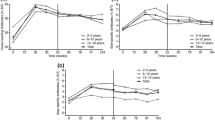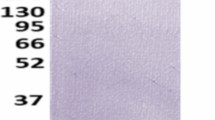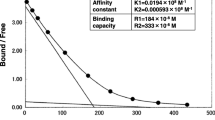Abstract
Administration of exogenous insulin for the treatment of diabetes is often accompanied by the development of insulin antibodies (IA). These antibodies may affect the patient’s requirement for insulin by acting as an insulin binding reservoir. The improvement of insulin purification in the 1970s and the development of human recombinant insulin both reduced the incidence of IA and their binding levels. This study investigates the parameters affecting IA frequency and binding levels in a cohort of type 1 diabetes (T1D) patients. All patients were treated with human recombinant insulin. About half of the patients had received animal insulin prior to the introduction of human recombinant insulin. We tested the IA frequency and binding level for all serum samples. IA were further analyzed for their epitope specificity comparing human and porcine insulin binding. We found that T1D patients who received animal insulin in the past show significantly higher IA binding levels as compared to patients treated exclusively with human recombinant insulin (IA binding level of 0.9 and 0.25 index, respectively, P = 0.005). T1D patients who received animal insulin in the past showed a relative bias towards porcine insulin, as compared to T1D patients who were treated with human recombinant insulin exclusively (P < 0.0001). We conclude that IA binding level and epitope specificity are biased by treatment with animal insulin. This bias remains for over 20 years after animal insulin treatment is terminated.


Similar content being viewed by others
References
Diaz JL, Wilkin T (1987) Differences in epitope restriction of autoantibodies to native human insulin (iaa) and antibodies to heterologous insulin (ia). Diabetes 36:66–72
Devendra D, Galloway TS, Horton SJ, Evenden A, Keller U, Wilkin TJ (2003) The use of phage display to distinguish insulin autoantibody (iaa) from insulin antibody (ia) idiotypes. Diabetologia 46:802–809. doi:10.1007/s00125-003-1107-7 [Epub 2003 Jun 3]
Hall TR, Thomas JW, Padoa CJ, Torn C, Landin-Olsson M, Ortqvist E, Hampe CS (2006) Longitudinal epitope analysis of insulin-binding antibodies in type 1 diabetes. Clin Exp Immunol 146:9–14. doi:10.1111/j.1365-2249.2006.03178.x
Jaeger C, Winter S, Eckhard M, Hardt P, Brendel MD, Bretzel RG (2008) Binding characteristics and crossreactivity of insulin autoantibodies and insulin antibodies directed to three different insulin molecules. Acta Diabetol 45:191–194. doi:10.1007/s00592-008-0041-z
Bingley PJ, Christie MR, Bonifacio E, Bonfanti R, Shattock M, Fonte MT, Bottazzo GF, Gale EA (1994) Combined analysis of autoantibodies improves prediction of iddm in islet cell antibody-positive relatives. Diabetes 43:1304–1310
Schernthaner G (1993) Immunogenicity and allergenic potential of animal and human insulins. Diabetes Care 16(Suppl 3):155–165
Fineberg SE, Galloway JA, Fineberg NS, Rathbun MJ, Hufferd S (1983) Immunogenicity of recombinant DNA human insulin. Diabetologia 25:465–469
Fineberg SE, Kawabata T, Finco-Kent D, Liu C, Krasner A (2005) Antibody response to inhaled insulin in patients with type 1 or type 2 diabetes. An analysis of initial phase ii and iii inhaled insulin (exubera) trials and a two-year extension trial. J Clin Endocrinol Metab 90:3287–3294. doi:10.1210/jc.2004-2229
Chute EP, Rupp WM, Rohde TD, Goldenberg FJ, Bordewich PH, Hitchcock CR, Blackshear PJ, Buchwald H (1984) Continuous single-rate long-term insulin infusion using a totally implantable pump. Trans Am Soc Artif Intern Organs 30:387–389
Chaillous L, Lefevre H, Thivolet C, Boitard C, Lahlou N, Atlan-Gepner C, Bouhanick B, Mogenet A, Nicolino M, Carel JC, Lecomte P, Marechaud R, Bougneres P, Charbonnel B, Sai P (2000) Oral insulin administration and residual beta-cell function in recent-onset type 1 diabetes: a multicentre randomised controlled trial. Diabete insuline orale group. Lancet 356:545–549
Pozzilli P, Pitocco D, Visalli N, Cavallo MG, Buzzetti R, Crino A, Spera S, Suraci C, Multari G, Cervoni M, Manca Bitti ML, Matteoli MC, Marietti G, Ferrazzoli F, Cassone Faldetta MR, Giordano C, Sbriglia M, Sarugeri E, Ghirlanda G (2000) No effect of oral insulin on residual beta-cell function in recent- onset type 1 diabetes (the imdiab vii). Imdiab group. Diabetologia 43:1000–1004
Garg S, Rosenstock J, Silverman BL, Sun B, Konkoy CS, De La Pena A, Muchmore DB (2006) Efficacy and safety of preprandial human insulin inhalation powder versus injectable insulin in patients with type 1 diabetes. Diabetologia 49:891–899. doi:10.1007/s00125-006-0161-3
Yu L, Robles DT, Abiru N, Kaur P, Rewers M, Kelemen K, Eisenbarth GS (2000) Early expression of antiinsulin autoantibodies of humans and the nod mouse: evidence for early determination of subsequent diabetes. Proc Natl Acad Sci USA 97:1701–1706. doi:10.1073/pnas.040556697
Hampe CS, Hammerle LP, Bekris L, Ortqvist E, Kockum I, Rolandsson O, Landin-Olsson M, Torn C, Persson B, Lernmark A (2000) Recognition of glutamic acid decarboxylase (gad) by autoantibodies from different gad antibody-positive phenotypes. J Clin Endocrinol Metab 85:4671–4679
Rolandsson O, Hägg E, Hampe C, Sullivan EP, Nilsson M, Jansson G, Hallmans G, Lernmark Å (1999) Levels of glutamate decarboxylase (gad65) and tyrosine phosphatase-like protein (ia-2) autoantibodies in the general population are related to glucose intolerance and body mass index. Diabetologia 42:555–559
Bingley PJ, Bonifacio E, Mueller PW (2003) Diabetes antibody standardization program: first assay proficiency evaluation. Diabetes 52:1128–1136
Francis AJ, Hanning I, Alberti KG (1985) The influence of insulin antibody levels on the plasma profiles and action of subcutaneously injected human and bovine short acting insulins. Diabetologia 28:330–334
Peters A, Klose O, Hefty R, Keck F, Kerner W (1995) The influence of insulin antibodies on the pharmacokinetics of nph insulin in patients with type 1 diabetes treated with human insulin. Diabet Med 12:925–930
Walford S, Allison SP, Reeves WG (1982) The effect of insulin antibodies on insulin dose and diabetic control. Diabetologia 22:106–110
Ludvigsson J (1984) Insulin antibodies in diabetic children treated with monocomponent porcine insulin from the onset: relationship to b-cell function and partial remission. Diabetologia 26:138–141
Keilacker H, Rjasanowski I, Ziegler M, Michaelis D, Woltanski KP, Besch W (1986) The role of insulin antibodies in insulin treatment of type i diabetes. Exp Clin Endocrinol 87:79–88
Sakata S, Matsuda M, Komaki T, Miura K (1986) Effect of anti-insulin antibodies on glycemic control in insulin treated diabetic patients. Immunol Invest 15:791–799
Richter B, Neises G (2005) ‘Human’ insulin versus animal insulin in people with diabetes mellitus. Cochrane Database Syst Rev 3:CD003816. doi:10.1002/14651858.CD003816.pub2
Fineberg SE, Galloway JA, Fineberg NS, Goldman J (1983) Effects of species of origin, purification levels, and formulation on insulin immunogenicity. Diabetes 32:592–599
Acknowledgments
The study was performed as independent research sponsored by the National Institutes of Health (DK53456), as well as by DK53004, DK26190, to Dr. Åke Lernmark, and by DK17047. T-T TP was funded through the National Institute of Health (the UW GenOM Project (P50HG02360-08) and the UW Microscale Life Sciences CenterMicroscale Life Sciences Center (HG002360-07)). We wish to thank Vasile M. Bota for expert help.
Author information
Authors and Affiliations
Corresponding author
Rights and permissions
About this article
Cite this article
Oak, S., Phan, TH.T., Gilliam, L.K. et al. Animal insulin therapy induces a biased insulin antibody response that persists for years after introduction of human insulin. Acta Diabetol 47, 131–135 (2010). https://doi.org/10.1007/s00592-009-0135-2
Received:
Accepted:
Published:
Issue Date:
DOI: https://doi.org/10.1007/s00592-009-0135-2




